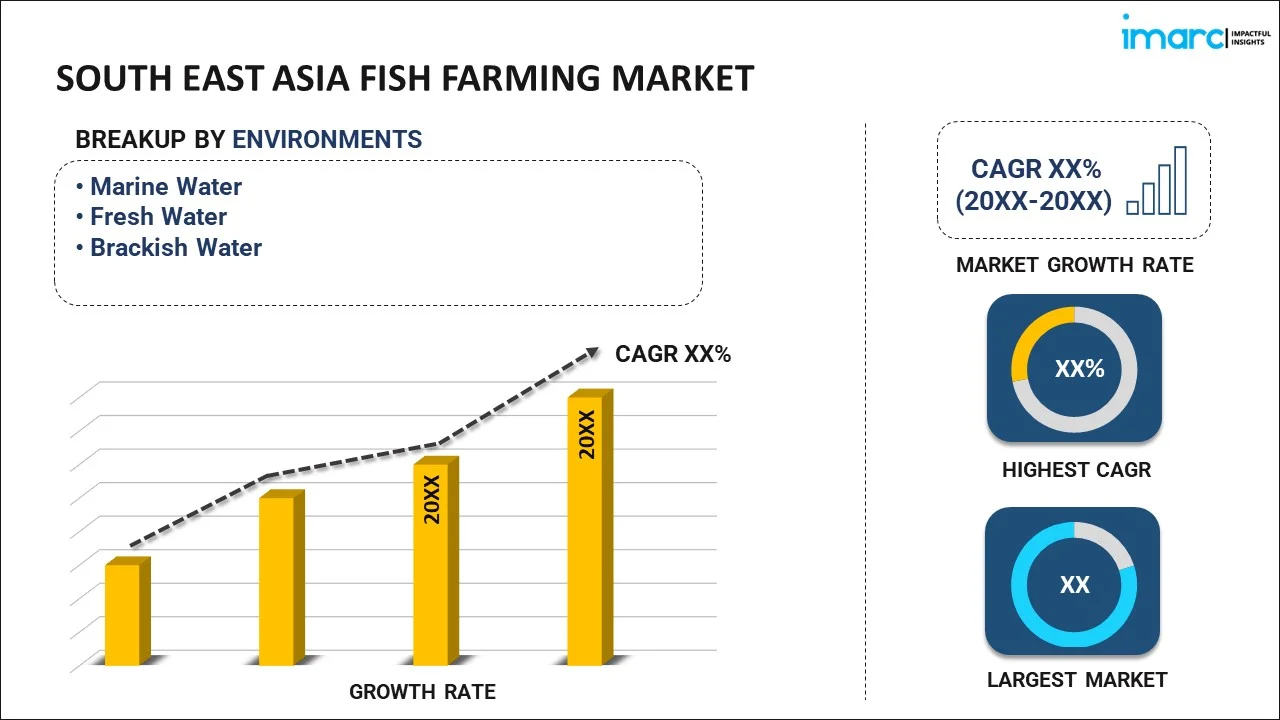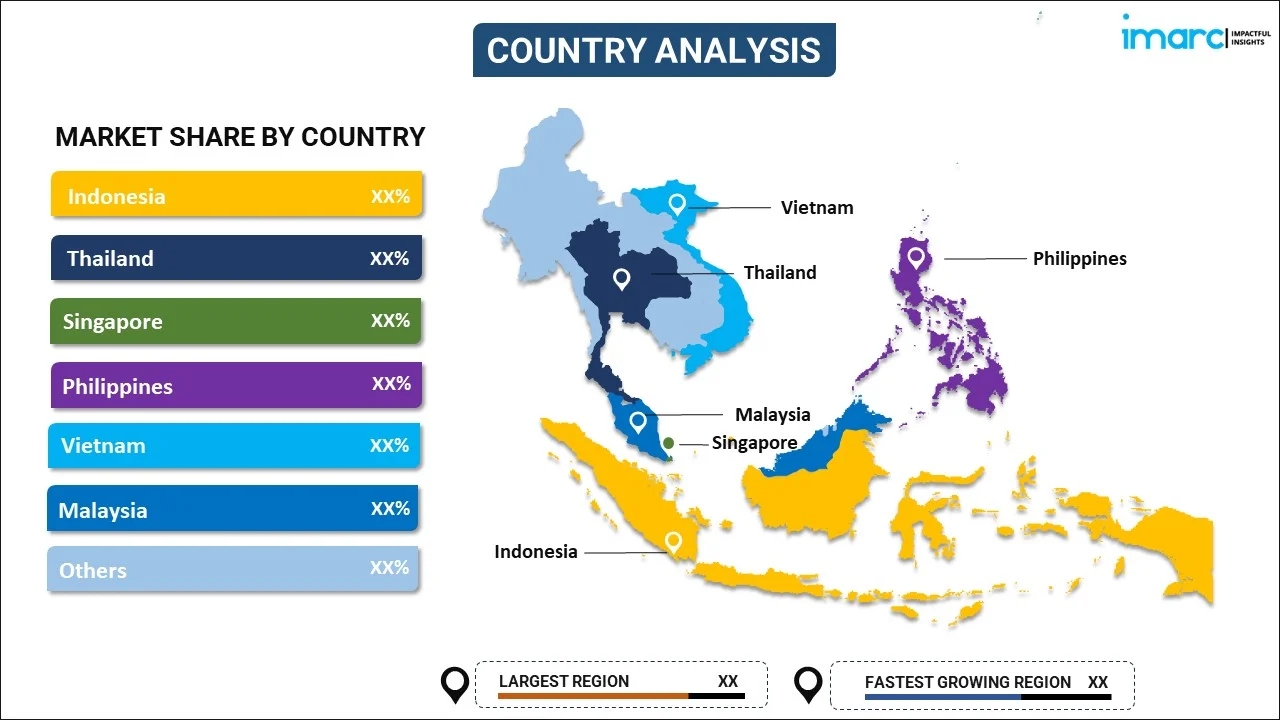
South East Asia Fish Farming Market Report by Environment (Marine Water, Fresh Water, Brackish Water), Fish Type (Salmon, Milkfish, Tuna, Tilapia, Catfish, Sea Bass, and Others), and Country 2024-2032
Market Overview:
South East Asia fish farming market size is projected to exhibit a growth rate (CAGR) of 5.04% during 2024-2032. The rising demand for seafood, depletion of wild fish stocks, rapid economic growth, favorable climate across the region, significant technological advancements, favorable government support, rising export opportunities, and ongoing research and development activities represent some of the key factors driving the market.
|
Report Attribute
|
Key Statistics
|
|---|---|
|
Base Year
|
2023 |
|
Forecast Years
|
2024-2032 |
|
Historical Years
|
2018-2023
|
| Market Growth Rate (2024-2032) | 5.04% |
Fish farming, also known as aquaculture, is the practice of cultivating and raising fish species in controlled environments such as ponds, tanks, or enclosures, with the primary goal of producing seafood for human consumption. This method of fish production has gained significant importance in recent years due to the growing global demand for fish as a source of protein. Fish farming involves various species, including tilapia, catfish, and trout, depending on the geographical location and market preferences. The process of fish farming typically begins with selecting suitable water bodies or constructing artificial systems to house the fish. Water quality, temperature, and oxygen levels are closely monitored to ensure optimal conditions for the fish's growth. Fish are fed with specially formulated diets to promote healthy development. As they grow, they are harvested and processed for sale in various forms, such as fresh, frozen, or processed seafood products.
South East Asia Fish Farming Market Trends:
Increasing consumer demand for seafood products, driven by population growth, higher disposable incomes, and changing dietary preferences, has propelled the South East Asia fish farming market. Seafood is a vital source of protein, and aquaculture helps meet this demand sustainably. Additionally, overfishing and the depletion of wild fish stocks have led to a shift toward aquaculture as a means to supplement seafood supply. Fish farming reduces pressure on ocean ecosystems and helps conserve marine biodiversity. Other than this, economic development in South East Asian countries has led to increased investments in aquaculture infrastructure and technology. Governments and private entities have recognized the potential of the industry for job creation and economic growth. Besides this, the tropical and subtropical climate of the region provides ideal conditions for fish farming year-round. This advantage allows for the cultivation of a wide range of fish species, contributing to market diversification. In line with this, increasing awareness about environmental sustainability has prompted a shift toward responsible aquaculture practices. Consumers are more inclined to choose products from farms that adhere to eco-friendly standards. Furthermore, advancements in aquaculture technology, such as automated feeding systems, water quality monitoring, and disease control measures, have improved production efficiency and reduced risks associated with fish farming. Apart from these factors, numerous South East Asian governments have introduced policies and initiatives to support the growth of the aquaculture sector. These include subsidies, regulatory frameworks, and incentives for sustainable practices. Moreover, ongoing research and development efforts in fish breeding, nutrition, and disease management have resulted in improved fish yields and reduced production costs.
South East Asia Fish Farming Market Segmentation:
IMARC Group provides an analysis of the key trends in each segment of the market, along with forecasts at the regional and country levels for 2024-2032. Our report has categorized the market based on environment and fish type.
Environment Insights:

- Marine Water
- Fresh Water
- Brackish Water
The report has provided a detailed breakup and analysis of the market based on the environment. This includes marine water, fresh water, and brackish water.
Fish Type Insights:
- Salmon
- Milkfish
- Tuna
- Tilapia
- Catfish
- Sea Bass
- Others
A detailed breakup and analysis of the market based on the fish type have also been provided in the report. This includes salmon, milkfish, tuna, tilapia, catfish, sea bass, and others.
Country Insights:

- Indonesia
- Thailand
- Singapore
- Philippines
- Vietnam
- Malaysia
- Others
The report has also provided a comprehensive analysis of all the major regional markets, which include Indonesia, Thailand, Singapore, Philippines, Vietnam, Malaysia, and Others.
Competitive Landscape:
The market research report has also provided a comprehensive analysis of the competitive landscape. Competitive analysis such as market structure, key player positioning, top winning strategies, competitive dashboard, and company evaluation quadrant has been covered in the report. Also, detailed profiles of all major companies have been provided.
South East Asia Fish Farming Market Report Coverage:
| Report Features | Details |
|---|---|
| Base Year of the Analysis | 2023 |
| Historical Period | 2018-2023 |
| Forecast Period | 2024-2032 |
| Units | US$ Billion |
| Scope of the Report | Exploration of Historical Trends and Market Outlook, Industry Catalysts and Challenges, Segment-Wise Historical and Future Market Assessment:
|
| Environments Covered | Marine Water, Fresh Water, Brackish Water |
| Fish Types Covered | Salmon, Milkfish, Tuna, Tilapia, Catfish, Sea Bass, Others |
| Countries Covered | Indonesia, Thailand, Singapore, Philippines, Vietnam, Malaysia, Others |
| Customization Scope | 10% Free Customization |
| Report Price and Purchase Option | Single User License: US$ 3699 Five User License: US$ 4699 Corporate License: US$ 5699 |
| Post-Sale Analyst Support | 10-12 Weeks |
| Delivery Format | PDF and Excel through Email (We can also provide the editable version of the report in PPT/Word format on special request) |
Key Questions Answered in This Report:
- How has the South East Asia fish farming market performed so far and how will it perform in the coming years?
- What has been the impact of COVID-19 on the South East Asia fish farming market?
- What is the breakup of the South East Asia fish farming market on the basis of environment?
- What is the breakup of the South East Asia fish farming market on the basis of fish type?
- What are the various stages in the value chain of the South East Asia fish farming market?
- What are the key driving factors and challenges in the South East Asia fish farming?
- What is the structure of the South East Asia fish farming market and who are the key players?
- What is the degree of competition in the South East Asia fish farming market?
Key Benefits for Stakeholders:
- IMARC’s industry report offers a comprehensive quantitative analysis of various market segments, historical and current market trends, market forecasts, and dynamics of the South East Asia fish farming market from 2018-2032.
- The research report provides the latest information on the market drivers, challenges, and opportunities in the South East Asia fish farming market.
- Porter's five forces analysis assist stakeholders in assessing the impact of new entrants, competitive rivalry, supplier power, buyer power, and the threat of substitution. It helps stakeholders to analyze the level of competition within the South East Asia fish farming industry and its attractiveness.
- Competitive landscape allows stakeholders to understand their competitive environment and provides an insight into the current positions of key players in the market.
Need more help?
- Speak to our experienced analysts for insights on the current market scenarios.
- Include additional segments and countries to customize the report as per your requirement.
- Gain an unparalleled competitive advantage in your domain by understanding how to utilize the report and positively impacting your operations and revenue.
- For further assistance, please connect with our analysts.
 Inquire Before Buying
Inquire Before Buying
 Speak to an Analyst
Speak to an Analyst
 Request Brochure
Request Brochure
 Request Customization
Request Customization




.webp)




.webp)












